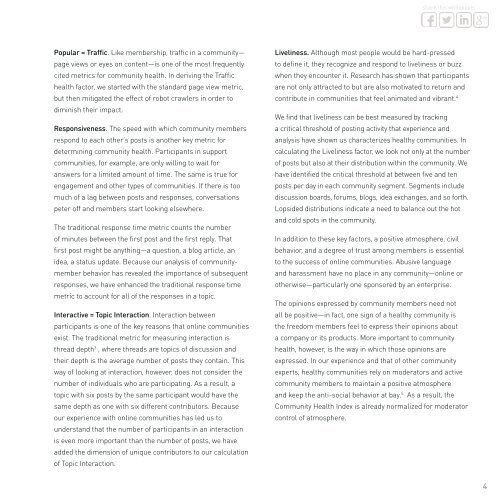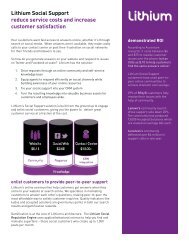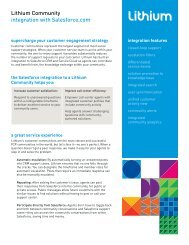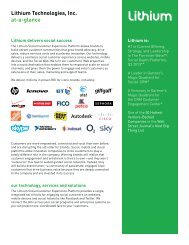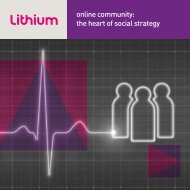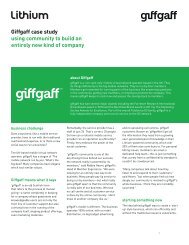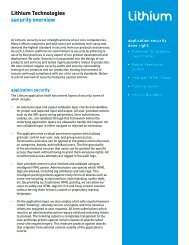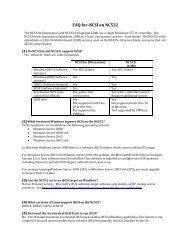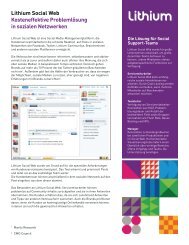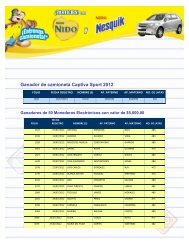Community Health Index - Lithium
Community Health Index - Lithium
Community Health Index - Lithium
Create successful ePaper yourself
Turn your PDF publications into a flip-book with our unique Google optimized e-Paper software.
Popular = Traffic. Like membership, traffic in a community—<br />
page views or eyes on content—is one of the most frequently<br />
cited metrics for community health. In deriving the Traffic<br />
health factor, we started with the standard page view metric,<br />
but then mitigated the effect of robot crawlers in order to<br />
diminish their impact.<br />
Responsiveness. The speed with which community members<br />
respond to each other’s posts is another key metric for<br />
determining community health. Participants in support<br />
communities, for example, are only willing to wait for<br />
answers for a limited amount of time. The same is true for<br />
engagement and other types of communities. If there is too<br />
much of a lag between posts and responses, conversations<br />
peter off and members start looking elsewhere.<br />
The traditional response time metric counts the number<br />
of minutes between the first post and the first reply. That<br />
first post might be anything—a question, a blog article, an<br />
idea, a status update. Because our analysis of communitymember<br />
behavior has revealed the importance of subsequent<br />
responses, we have enhanced the traditional response time<br />
metric to account for all of the responses in a topic.<br />
Interactive = Topic Interaction. Interaction between<br />
participants is one of the key reasons that online communities<br />
exist. The traditional metric for measuring interaction is<br />
thread depth3 , where threads are topics of discussion and<br />
their depth is the average number of posts they contain. This<br />
way of looking at interaction, however, does not consider the<br />
number of individuals who are participating. As a result, a<br />
topic with six posts by the same participant would have the<br />
same depth as one with six different contributors. Because<br />
our experience with online communities has led us to<br />
understand that the number of participants in an interaction<br />
is even more important than the number of posts, we have<br />
added the dimension of unique contributors to our calculation<br />
of Topic Interaction.<br />
share this whitepaper<br />
Liveliness. Although most people would be hard-pressed<br />
to define it, they recognize and respond to liveliness or buzz<br />
when they encounter it. Research has shown that participants<br />
are not only attracted to but are also motivated to return and<br />
contribute in communities that feel animated and vibrant. 4<br />
We find that liveliness can be best measured by tracking<br />
a critical threshold of posting activity that experience and<br />
analysis have shown us characterizes healthy communities. In<br />
calculating the Liveliness factor, we look not only at the number<br />
of posts but also at their distribution within the community. We<br />
have identified the critical threshold at between five and ten<br />
posts per day in each community segment. Segments include<br />
discussion boards, forums, blogs, idea exchanges, and so forth.<br />
Lopsided distributions indicate a need to balance out the hot<br />
and cold spots in the community.<br />
In addition to these key factors, a positive atmosphere, civil<br />
behavior, and a degree of trust among members is essential<br />
to the success of online communities. Abusive language<br />
and harassment have no place in any community—online or<br />
otherwise—particularly one sponsored by an enterprise.<br />
The opinions expressed by community members need not<br />
all be positive—in fact, one sign of a healthy community is<br />
the freedom members feel to express their opinions about<br />
a company or its products. More important to community<br />
health, however, is the way in which those opinions are<br />
expressed. In our experience and that of other community<br />
experts, healthy communities rely on moderators and active<br />
community members to maintain a positive atmosphere<br />
and keep the anti-social behavior at bay. 5 As a result, the<br />
<strong>Community</strong> <strong>Health</strong> <strong>Index</strong> is already normalized for moderator<br />
control of atmosphere.<br />
4


